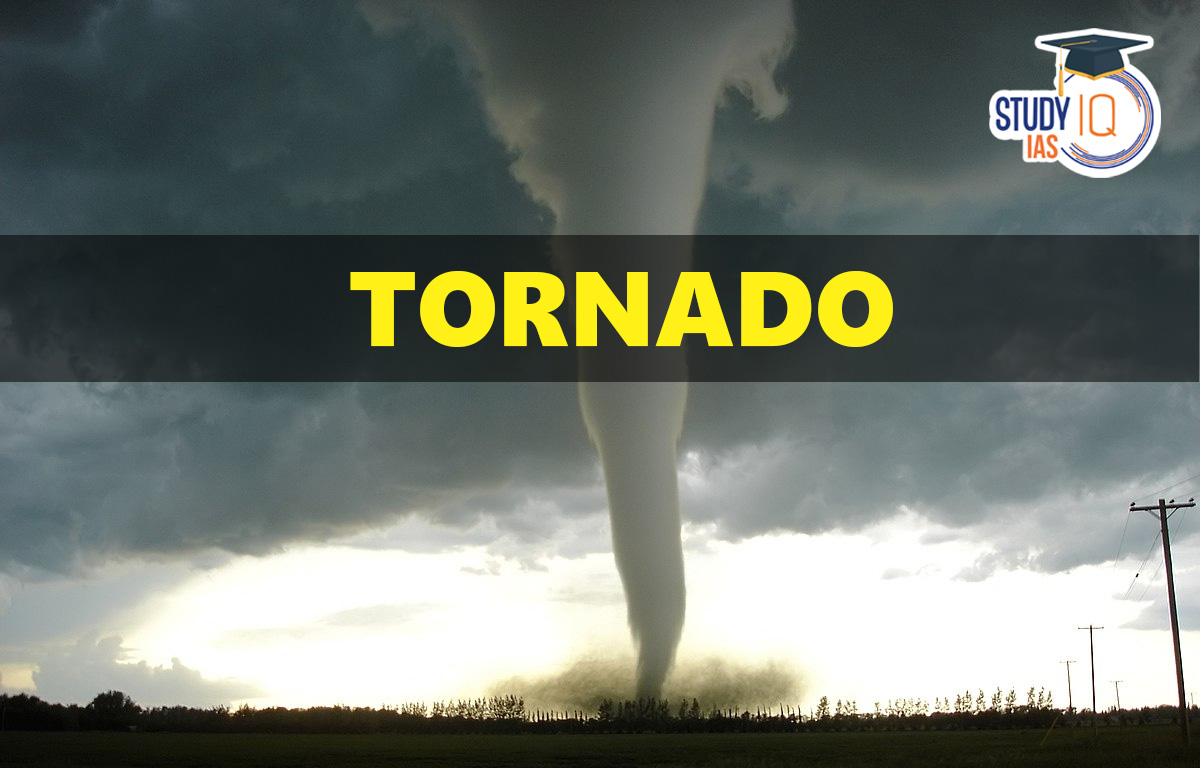Table of Contents
What is Tornado?
Tornadoes are powerful spinning columns of air that reach from a thunderstorm down to the ground. They can cause a lot of damage, destroying buildings, flipping cars, and sending dangerous debris flying.
A tornado can:
- Occur at any time and in any place.
- Have winds that can exceed 200 miles per hour.
- Look like a funnel shape.
A tornado is a violently rotating column of air that collides with the Earth’s surface, a Cumulonimbus Clouds, or, on rare occasions, the base of a cumulus cloud.
They are small but extremely violent and destructive. Tornadoes usually happen in middle latitudes, where strong pressure differences cause air to rush toward the center. This incoming air gets caught in the storm’s vortex and quickly rises. As it ascends, the air cools and forms Thunderstorms.
Tornadoes can completely demolish well-built structures, uproot trees, and launch objects through the air like devastating missiles. This article will explain tornadoes, which will help you prepare for the UPSC Civil Service exam’s Geography syllabus.
Read More: Types of Winds
Tornado Formation
As air rises in a thunderstorm, it can start to spin if different winds push it in various directions. This spinning happens in supercell thunderstorms, which are the strongest type, but not all spinning air turns into a tornado. For a tornado to form, there must also be spinning air near the ground. This occurs when gusts of air, both warm and cool, move across the land. If there are enough of these gusts, the air near the ground begins to spin.
As this spinning air is pulled inward, it speeds up, similar to how a figure skater spins faster when they pull their arms in. This creates a rotating column of air that can tilt vertically, leading to a tornado.
While most tornadoes occur during supercell thunderstorms, not every supercell produces one. Sometimes the air near the ground does not spin fast enough, or if it is too cold, it spreads out and slows down, preventing a tornado from forming.
Cause of Tornadoes
Tornadoes form when warm, moist air meets cold, dry air. This usually happens when cooler air pushes over warmer air, creating thunderstorms. The warm air rises, and when the wind changes direction or speed, it causes the rising air to start spinning.
Tornadoes Effects
In the United States, tornadoes cause about $400 million in damage each year and lead to around 70 deaths on average. They can destroy homes and businesses with their powerful winds, which can rip bark off trees, collapse bridges, flip trains, and even drain rivers.
Tornadoes and Severe Storms
Tornadoes are funnel-shaped clouds that form during severe thunderstorms. They connect the storm to the ground and have winds that can start at 30 mph and quickly reach 70 mph. In the U.S., they are usually about 500 feet wide and can travel for five miles, making a loud noise like a freight train.
Tornadoes pose a serious threat, bringing strong winds, lightning, and flash floods. They can strike suddenly, giving people little time to find shelter, leading to fear and distress.
Tornadoes Occur in?
Most tornadoes happen in the Great Plains of central America, also known as Tornado Alley. This area is where dry, cold air from Canada meets warm, moist air from the Gulf of Mexico. Tornadoes can happen any time of year, but they are most common in spring and summer, especially in May and June.
Read More: List of Major Local Winds
Tornadoes Structure
Separate airflow areas exist in tornadoes with fully developed airflow. As shown in the diagram, the primary axis of circulation is located within the core region, a roughly cylindrical area of lower air pressure bounded by the maximum tangential winds. If a visible funnel cloud forms within the core region, it will be visible. The condensation funnel is the cloud’s column of water droplets. If the weather is extremely dry, a tornado may not have a condensation funnel. Air near the ground, known as the inflow boundary layer, converges from all directions into a tornado’s “corner region” in response to the reduced pressure in the central core.
When the wind enters the center of a tornado and starts to spiral upward, it changes from moving mostly sideways to moving straight up, which is why this area is called the “core.” The area around this corner is very dangerous. As the wind rushes in, it picks up dirt and debris from the ground, creating a swirling cloud of dust or debris fountain. Usually, the turbulent air that feeds this corner is about a few tens of meters deep, and there’s a slowly spinning layer of air above it that surrounds the core.
Read More: Types of Clouds
Read More: Equatorial Climate Region
Tornadoes Significance
- Tornadoes provide a lot of nitrogen to the soil as well as water to the plants.
- A tornado is the most efficient way to transfer air from one section of the atmosphere to another in terms of size and time.
- Tornadoes, with their massive movement, aid in seed pollination.
- It also destroys old-growth trees, which provide habitat for wildlife in the area.
- Tornadoes are well-known for uprooting large trees and transporting them to a new location.
Read More: Precipitation
Tornado and Cyclone Difference
| Cyclone | Tornado |
| A cyclone is a large circulating air mass with a central vortex. | A tornado is a revolving column of air that forms a funnel shape as it approaches land. |
| Cyclones are most common near oceans and coastlines. | Tornadoes are most common on the mainland. |
| The Saffir-Simpson wind scale and the Beauford scale are used to determine the intensity of a cyclone. | The enhanced Fujita scale is used to determine the intensity of a tornado. |
| Cyclones could be several hundred miles in length. | Tornadoes can be up to 12 miles wide, but they can be much larger. |
| Cyclones can last for several weeks. | Tornadoes last only minutes to hours. |
| Cyclone frequency varies according to the type of cyclone. | Tornadoes can occur several hundred times per year. |
| A cyclone produces rain in the form of precipitation. | A tornado can produce rain, sleet, or hail as precipitation. |
Despite their differences, cyclones and tornadoes are both extremely powerful storms. When looking at different storms, especially those with revolving winds, it can be difficult to tell them apart — the main difference between a tornado and a cyclone is where and why it forms. A cyclone forms over water, whereas a tornado forms over land.
Individuals are at risk of being struck by flying and falling debris during tornadoes and cyclones due to extremely high winds and waves. The devastation caused by tornadoes and cyclones raises serious safety concerns. Although there is little you can do to prevent tornadoes, you can take precautions to protect your health and safety.
Read More: Humidity
Tornado UPSC
Tornadoes and cyclones occur in India. Tornadoes, unlike cyclones, occur on a relatively infrequent basis. Tornadoes of moderate strength strike the country’s northwestern and north-eastern regions, causing significant damage to people and property. Cyclones form in the Bay of Bengal and the Arabian Sea, while weak tornadoes occur in the country’s northwestern and northeastern regions.


 Story of Meera Bai and Her Devotion For ...
Story of Meera Bai and Her Devotion For ...
 Desert Climate, Distribution, Climatic C...
Desert Climate, Distribution, Climatic C...
 Deserts of India Map, Features of Thar D...
Deserts of India Map, Features of Thar D...





















